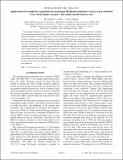Application of asymptotic expansions for maximum likelihood estimators errors to gravitational waves from binary mergers: The single interferometer case
Author(s)
Zanolin, M.; Vitale, S.; Makris, Nicholas
DownloadZanolin-2010-Application of asymp.pdf (2.873Mb)
PUBLISHER_POLICY
Publisher Policy
Article is made available in accordance with the publisher's policy and may be subject to US copyright law. Please refer to the publisher's site for terms of use.
Terms of use
Metadata
Show full item recordAbstract
In this paper we apply to gravitational waves (GW) from the inspiral phase of binary systems a recently derived frequentist methodology to calculate analytically the error for a maximum likelihood estimate of physical parameters. We use expansions of the covariance and the bias of a maximum likelihood estimate in terms of inverse powers of the signal-to-noise ration (SNR)s where the square root of the first order in the covariance expansion is the Cramer Rao lower bound (CRLB). We evaluate the expansions, for the first time, for GW signals in noises of GW interferometers. The examples are limited to a single, optimally oriented, interferometer. We also compare the error estimates using the first two orders of the expansions with existing numerical Monte Carlo simulations. The first two orders of the covariance allow us to get error predictions closer to what is observed in numerical simulations than the CRLB. The methodology also predicts a necessary SNR to approximate the error with the CRLB and provides new insight on the relationship between waveform properties, SNR, dimension of the parameter space and estimation errors. For example the timing match filtering can achieve the CRLB only if the SNR is larger than the Kurtosis of the gravitational wave spectrum and the necessary SNR is much larger if other physical parameters are also unknown.
Date issued
2010-06Department
Massachusetts Institute of Technology. Department of Mechanical EngineeringJournal
Physical Review D
Publisher
American Physical Society
Citation
Zanolin, M. S. Vitale, and N. Makris "Application of asymptotic expansions for maximum likelihood estimators errors to gravitational waves from binary mergers: The single interferometer case." Physical Review D 81.12 (2010): 124048. © 2010 The American Physical Society
Version: Final published version
ISSN
1550-7998
1550-2368